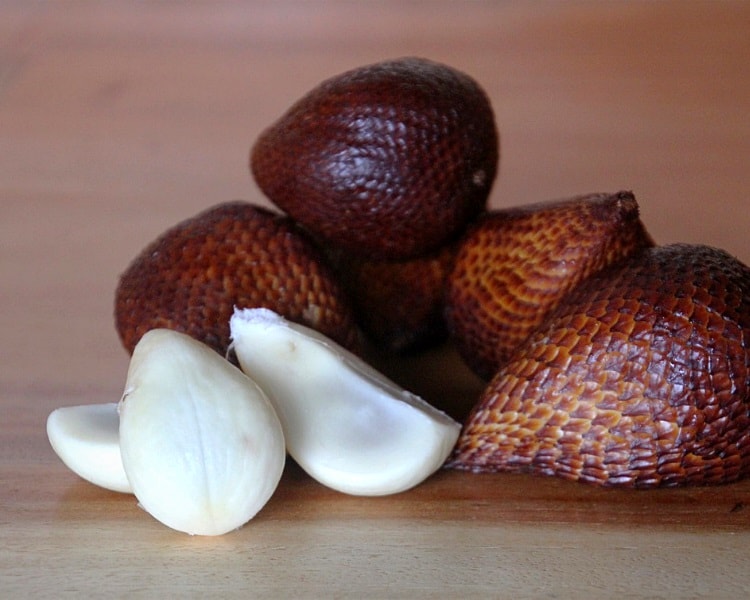Last updated: March 18, 2024
In my quest to find new, exciting fruits to try, I had the pleasure of eating snake fruit during my recent travels through Southeast Asia.
While snake fruit, also known as salak, is perhaps not as delicious and refreshing as other exotic fruits I’ve tried in the past, I was pleasantly surprised by this fruit’s unique flavors and texture.
In this article, we’re going to learn more about the rather unique snake fruit, its origins, nutritional profile, and potential benefits.
What Is a Snake Fruit?
The snake fruit is produced by the salak tree, a palm tree family native to Sumatra and Java in Indonesia.
Salak is now also being cultivated in other regions in and around Indonesia, resulting in different variations of the fruit.
The shape and size of a snake fruit resemble those of a fig, with a distinct tip. But the fruit’s dark, scaly skin gave it its name.

Perhaps the best spot to find and taste snake fruit is Bali, one of Indonesia’s most popular tourist destinations. The fruit is quite popular there, just like many other tropical fruits.
Otherwise, you will most likely also be able to find the fruit in Bangkok and other popular areas in Thailand.
How to Eat Snake Fruit?
The best way to eat a snake fruit is by removing the stem and then cracking the fruit open. You can then simply peel off the skin.
What’s interesting is that the inside of a snake fruit looks a bit like large garlic cloves. Once you’ve peeled one, you will understand what I mean!
Inside, you will see three lobes: two larger ones and a smaller one. The larger ones contain seeds, which are not edible. In some cases, the smaller lobe also contains a seed.

The lobes are covered in a film-like layer, similar to a boiled and peeled egg. This layer should be removed before eating.
The texture of the flesh of the lobes is a bit like that of an apple. Depending on the type and ripeness of the fruit, the texture varies from crunchy to crumbly, with a mix of bitter, acidic, and sweet flavors.
Nutritional Profile and Benefits
The salak fruit has quite an interesting nutritional profile. It is particularly high in iron, phosphorus, vitamin C, and calcium.
Even more surprising is that the fruit contains almost 1 gram of dietary fiber per 100 grams.

The nutritional profile below is taken from Wikipedia, but it doesn’t appear to be complete.
A complete list of nutrients proves hard to find, but according to other sources, the fruit also contains reasonable amounts of potassium and vitamins B1 and B2.
| Snake fruit (raw – 100 g) | |
|---|---|
| Energy: | 368 cal |
| Protein: | 0.8 g |
| Fat: | 0.4 g |
| Dietary fiber: | 0.3 g |
| Iron: | 3.9 mg (30% DV) |
| Calcium: | 38 mg (4% DV) |
| Phosphorus: | 18 mg (3% DV) |
| Vitamin C: | 8.4 mg (10% DV) |
| Source: Wikipedia | |
Benefits
Snake fruit is also often referred to as the “memory fruit”, supposedly due to its potassium content.
Potassium is a mineral that supports various types of body functions, including the brain’s memory function.

The calcium in snake fruit supports the health, structure, and functioning of our teeth and bones, and iron helps to preserve vital functions in the body, including maintaining energy levels and focus.
I should also mention that, according to several sources, snake fruit supposedly has anti-diarrheal properties. In other words, eating too much of this fruit can lead to constipation. How interesting!
Lastly, like so many other fruits, salak offers antioxidants that help our bodies combat and prevent illnesses.
Final Thoughts
So there you have it, an introduction to snake fruit, another exotic treat you may have never seen or heard of before.
I genuinely love discovering fruits (and vegetables) that are just a bit different and more unique than what we can find in our local supermarkets. read my list of unusual vegetables if you’re keen to try out some new veggies.
Our planet has so much to offer in terms of fruits and vegetables, each with its own identity and unique set of nutrients and flavors.
If you like snake fruit, you may also be interested in cherimoya fruit. That’s another exotic treat that tastes really good, especially compared to salak.

